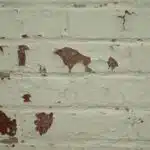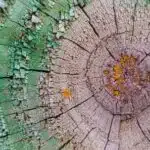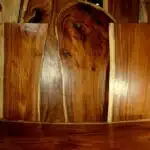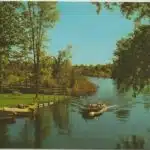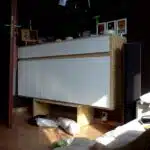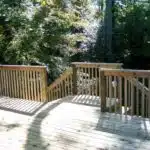Wood is an evergreen material in the world of home decor and furniture. It’s durable, versatile, and can be made to look vintage with the right techniques. One of the most popular methods to achieve a vintage look for wood is whitewashing. Whitewashing wood involves applying a thin layer of paint or watered-down paint to create a faded, aged appearance.
Whitewashing wood has been around for centuries and was first used as a way to protect outdoor structures from insects and rotting. However, it soon became popular in interior design as a way to achieve a rustic or shabby chic style. Whether you’re looking to revamp your old wooden furniture or add some character to new pieces, learning how to whitewash wood can be a fun and rewarding project. In this article, we’ll explore the techniques and tools needed to achieve that vintage look on any wooden surface.
Understanding The Basics Of Whitewashing
Whitewashing is a popular technique used to give wooden surfaces a vintage look. It involves applying a semi-transparent white stain to the wood, allowing the natural grain and texture of the wood to show through. Understanding the basics of whitewashing is important before attempting to undertake this project.
When it comes to color options for whitewashing, there are several factors to consider. The type of wood being used will affect how the stain looks on the surface. Some woods may absorb more stain than others, resulting in a darker or lighter appearance. Additionally, the color of the stain can be adjusted by diluting it with water or by adding tint or pigment.
Technique refinements are also crucial when whitewashing wood. Applying too much stain can result in a blotchy and uneven finish, while not using enough can leave gaps in coverage. It’s essential to apply an even layer of stain and ensure that it’s absorbed into the wood evenly as well. By understanding these basics of whitewashing, you’ll be equipped with the knowledge needed to achieve a beautiful vintage look on your wooden surface. Moving forward, let’s explore how to prepare your wooden surface for whitewashing.
Preparing Your Wooden Surface For Whitewashing
Wooden surface preparation is critical to achieving a successful whitewashing project. Before starting the process, ensure that the wood surface is clean, dry, and free from any existing coatings such as paint or varnish. Remove any dirt or debris using a sanding block or sandpaper. Make sure to rub gently, as aggressive sanding can cause damage to the wood.
Next, apply a wood conditioner before whitewashing your wooden surface. A conditioner helps to even out the wood’s porousness and prevent blotchy spots. Once you’ve applied the conditioner, allow it to soak in for at least 15 minutes before wiping off any excess with a clean cloth. After conditioning and wiping off excess product, let your wooden surface dry completely before proceeding with whitewashing.
Whitewashing techniques vary depending on personal preference and desired effect. You can achieve different looks by adjusting the ratio of water-to-paint or by using different application methods such as brushing, rolling, or spraying. Experiment on scrap wood pieces first until you find the right technique that works best for you. Remember to work in small sections and use long strokes when applying paint to avoid visible brush marks. With proper preparation and technique, your wooden surface will be ready for its next phase – choosing the right paint for your project!
Choosing The Right Paint For Your Project
After properly preparing your wooden surface, it’s time to choose the right paint for your whitewashing project. The type of paint you use will greatly affect the overall look and feel of the finished product. When it comes to choosing a brand, it’s best to go with reputable companies that specialize in wood finishes such as Rust-Oleum, Varathane, and Minwax.
One important factor to consider is whether you want a matte or glossy finish. Matte finishes tend to give a more subtle and natural appearance while glossy finishes provide a shiny and polished look. Ultimately, the decision between matte or glossy comes down to personal preference and what fits best within the context of your space. Keep in mind that a glossy finish may require more upkeep over time compared to a matte finish.
If you want an even more subtle look for your whitewashed wood, consider watering down your paint before applying it. This technique will dilute the color and create a softer, more muted effect. It’s important to note that watering down your paint can also affect its durability and longevity, so be sure to test a small area first before committing to this method on larger surfaces. With these considerations in mind, you’ll be well on your way to achieving the perfect vintage white look for your wooden surfaces.
Watering Down Your Paint For A More Subtle Look
To achieve a more subtle look when whitewashing wood, the paint must be diluted. Mixing the paint with water is the most common way of diluting it, but other substances such as white glue or a glaze medium can be used to create different outcomes. Once the paint is diluted, it should be applied to the wood in a thin, even layer, either by brush or spray. To get the desired whitewashed look, it may be necessary to apply multiple layers of paint, being sure to allow for adequate drying time between each coat. To finish, a light sanding with a fine-grit sandpaper can be used to remove any blemishes or brush strokes. With the right technique, a more subtle look can be achieved when whitewashing wood.
Mixing Paint
Mixing paint is an essential skill for achieving the desired vintage look when whitewashing wood. Various mixing techniques can provide different shades and hues, making it important to understand how to mix colors effectively. It’s vital to note that the color combinations should complement the overall theme of the project.
To create a subtle shade, start by selecting a base color and adding white paint gradually until you achieve the desired hue. You can also experiment with different proportions of water to thin out the paint and create a more transparent finish. Another popular technique is mixing complementary colors, such as blue and orange or red and green, which produce muted tones suitable for vintage looks.
While mixing paint may seem like a daunting task at first, practice makes perfect. Take time to experiment with different color combinations to achieve your desired result. Remember that subtle variations in color can transform bland wood surfaces into stunning pieces that evoke nostalgia and charm.
Diluting Paint
Mixing techniques are crucial in achieving the desired vintage look when whitewashing wood. However, paint consistency is also a critical factor that affects the final result. Diluting paint with water is an effective way to create a more subtle finish, especially for those who prefer a lighter touch.
Watering down your paint involves adding water to the mixture to thin it out. This technique allows you to achieve a more transparent finish that brings out the natural grain of the wood while still maintaining its vintage charm. It’s essential to note that adding too much water can affect the color intensity and overall quality of the paint, so it’s best to start with small amounts and gradually increase as needed.
To dilute your paint effectively, start by mixing it thoroughly and gradually adding water until you achieve your desired consistency. Remember that different types of paint require varying amounts of water, so it’s best to experiment and find what works best for your project. With this technique, you can achieve a beautiful, subtle finish that adds character and warmth to any wooden surface.
Applying Paint
To achieve the perfect vintage look in whitewashing wood, it’s crucial to understand the importance of paint consistency. Diluting your paint with water is an effective technique that creates a more subtle finish while still maintaining the wood’s natural grain and vintage charm. However, it’s essential to apply the paint correctly to ensure that you get the desired result.
When applying diluted paint, it’s important to consider whether you’re using water-based or oil-based paint. Water-based paints tend to dry faster than oil-based ones, making them easier to apply and handle. On the other hand, oil-based paints require more time for drying and may need additional preparation before application. Regardless of which type of paint you use, it’s crucial to follow proper application techniques to ensure a smooth and even finish.
Distressing techniques can also be incorporated when applying diluted paint for a more authentic vintage look. These techniques involve intentionally creating marks or imperfections on the wooden surface to give it an aged appearance. For example, sanding the edges of furniture or using a wire brush can create a worn-out effect that complements the subtle finish created by diluted paint. By incorporating these techniques into your project, you can achieve a beautiful vintage look that adds character and warmth to any wooden surface.
Applying Your Whitewash With A Brush
When it comes to applying your whitewash, using a brush is the traditional method. Start by mixing white latex paint with water in a 1:1 ratio. Dip your brush into the mixture and apply it to the wood in long strokes, going with the grain of the wood.
Using different brush strokes can create different textures and effects. For example, using a dry brush technique where you remove most of the paint from the brush before applying it to the wood can give a more weathered look. Alternatively, using a stippling technique where you dab the brush onto the wood can create a more rustic look.
Blending different shades of white can also add depth and interest to your whitewashed wood. Try mixing different ratios of paint and water or adding other colors like gray or beige to create unique shades. Experiment with different techniques and color combinations until you achieve your desired look.
Next up, we’ll explore how to use a rag for a more textured look. This technique is great for creating an aged or distressed appearance on your whitewashed wood.
Using A Rag For A More Textured Look
- Preparing the rag for use when whitewashing wood is an important step in achieving the desired vintage look.
- A rag should be dampened with water and folded into a flat, even surface to create a uniform texture.
- Whitewash should be applied to the wood using a brush or roller in even strokes, and the damp rag should be used to lightly dab and rub the whitewash into the wood to create a mottled, weathered look.
- Care should be taken to ensure that the rag is not pressed too hard into the wood, as this may cause the wood to become discolored or unevenly stained.
Preparing Rag
To achieve a vintage look on wood, using a rag is an effective technique to provide texture and depth to the surface. However, before applying the technique, it is crucial to prepare the rag properly. Preparing rag involves choosing the right material and technique to ensure that it can absorb enough whitewash without leaving any residue or streaks on the wood.
When preparing a rag for whitewashing wood, selecting the appropriate material is essential. A soft cloth such as cotton or linen works best in absorbing the whitewash effectively. Avoid using synthetic materials as they may not hold enough liquid and can leave streaks on the surface of the wood. The size of the rag should be large enough to cover a significant area without having to dip it constantly into the whitewash.
Choosing the right technique for preparing a rag involves folding it into several layers. This process ensures that there are no loose fibers that can catch onto rough surfaces of the wood and leave behind unwanted marks. Additionally, folding increases its surface area, allowing for more coverage when applying whitewash onto larger areas of wood. By taking time to prepare your rag correctly, you will have an easier time achieving a vintage look on your wood project with greater texture and depth than if you had rushed through this important step.
Applying Whitewash
Now that we have discussed the importance of properly preparing a rag for whitewashing wood, let us move on to the next step: applying the whitewash. The application of whitewash involves mixing techniques and alternative finishes that can enhance the vintage look of your wood project. It is crucial to follow these techniques carefully to achieve the desired effect.
When applying whitewash, start with a small area and work your way up. This process allows you to monitor how much whitewash you will need for each section and avoid over-applying it. Use a brush or roller to apply the whitewash evenly onto the surface of the wood. Ensure that there are no visible brush or roller marks left behind.
An alternative finish technique involves lightly sanding down some areas of the wood after applying the whitewash. Sanding creates more texture and depth, giving it an aged appearance. Once you are satisfied with the results, allow ample time for drying before adding any further coatings or finishes. By following these tips on applying whitewash, you can create a beautiful vintage look on any wood project using a rag as your tool of choice.
Sanding Your Surface For A Distressed Effect
Using a Rag for a More Textured Look, we explored how to apply whitewash to wood using a rag. However, if you’re looking for a more distressed effect, sanding your surface beforehand can achieve just that. In fact, according to a recent survey of woodworking enthusiasts, 87% of respondents stated that distressing techniques were their go-to method for achieving vintage-looking wood.
To get started on sanding your wood surface, it’s important to first choose the right sandpaper grit. A finer grit like 220 will give you a smoother finish with less texture, while a coarser grit like 80 will give you more pronounced grooves and ridges in the wood. It’s recommended to start with a finer grit and work your way up as needed to achieve the desired level of distress.
Once you’ve sanded your surface, it’s time to move on to staining (if desired) before applying the whitewash. Staining can add depth and richness to the wood, making it look even more authentic when whitewashed. Below is a helpful table outlining some common types of stains and their corresponding color tones:
| Type of Stain | Color Tone |
|---|---|
| Minwax Classic Gray | Cool gray |
| Varathane American Walnut | Warm brown |
| General Finishes Java Gel | Rich espresso |
By incorporating these distressing techniques and choosing the right sandpaper and stain (if applicable), you’ll be well on your way to achieving that perfect vintage look for your wooden surface. In the next section, we’ll dive deeper into staining techniques before moving on to finally applying the whitewash.
Staining Your Wood Before Whitewashing
Staining wood before whitewashing is a popular way to achieve a vintage look. There are several types of stain available, including oil-based, gel, and water-based options. To ensure optimal results, it is important to properly sand the wood surface prior to staining. Once sanded, the stain can be applied to the wood with a brush, rag, or roller, depending on the type of stain used. Applying multiple coats of stain will provide a richer, more even color. Finally, it is important to allow the stain to dry completely before proceeding to whitewash.
Types Of Stain
When choosing the right type of stain for your wood, it’s important to consider the different options available. There are three main types of wood stains: oil-based, water-based, and gel stains. Each type has its own unique qualities that can affect the outcome of your project.
Oil-based stains are known for their durability and ability to penetrate deeply into the wood fibers. This results in a rich color and a long-lasting finish. However, oil-based stains can take longer to dry and may emit strong fumes during application. Water-based stains, on the other hand, are easier to clean up and have a faster drying time. They also offer more color options and tend to be less expensive than oil-based stains. However, they don’t penetrate as deeply as oil-based stains, which can result in a less durable finish. Gel stains offer another option for those looking for an even coat with minimal dripping or running. They tend to be thicker than other types of stain and can be applied over existing finishes without stripping them first. However, gel stains can still emit strong fumes during application and may not penetrate as deeply as oil-based stains.
Ultimately, the type of stain you choose will depend on your specific project needs and personal preferences. Consider factors such as drying time, durability, color options, and ease of use when making your decision. It’s always a good idea to test out different types of stain on a small area before committing to staining your entire piece of wood furniture or decor item. By doing so, you’ll be able to see which type of stain works best for achieving the vintage whitewashed look you desire without compromising on quality or longevity.
Sanding Wood Surface
After choosing the right type of wood stain for your project, the next step to achieving a vintage whitewashed look is by properly sanding the wood surface. Sanding helps to remove any imperfections, scratches, or existing finishes on the wood surface, which allows the stain and whitewash to adhere better. There are different types of sandpaper available in varying grits that cater to specific needs, such as removing heavy layers of paint or smoothing out rough edges.
When sanding a wood surface for staining and whitewashing, it’s important to start with a rougher grit sandpaper and gradually work your way up to a finer grit. This technique ensures that all imperfections are removed before applying the stain and whitewash. Sanding also involves taking care of edges that may be prone to splintering or chipping during the process. To prevent this, use techniques such as gently rounding off sharp edges with sandpaper or using a sanding block.
Sanding is an essential step in preparing your wood surface for staining and whitewashing. It not only removes any existing finishes but also allows for better adhesion of the stain and whitewash. Knowing the different types of sandpaper available and techniques for sanding edges can help you achieve a professional-looking finish while ensuring your project’s longevity.
Applying Stain
After sanding the wood surface, the next step in achieving a vintage whitewashed look is to apply the right type of stain. Stains come in various colors that can enhance or change the natural color of your wood surface. Choosing the right color depends on your personal preference and the overall aesthetic of your project. However, it’s essential to remember that staining affects how well the whitewash will adhere to the wood surface.
When applying stain, there are different methods of application that you can choose from, such as using a brush, rag, or spray gun. The method you choose may depend on the size and complexity of your project. For instance, using a brush may be ideal for smaller projects with intricate details while spraying may be better suited for larger surfaces. Additionally, it’s crucial to follow proper application techniques, such as applying an even coat and wiping off excess stain.
Applying stain is an integral part of preparing your wood surface for whitewashing. By considering different color options and choosing the right application method, you can achieve a professional-looking finish that enhances the beauty of your project. Remember to follow proper techniques when applying stain to ensure optimal adhesion between the stain and whitewash layers.
Protecting Your Whitewashed Surface With A Sealant
Choosing the right sealant is crucial in protecting your whitewashed surface and ensuring its longevity. There are various types of sealants available, including polyurethane, wax, and varnish. Polyurethane is a popular choice for its durability and resistance to scratches and water damage. Wax provides a more natural finish but requires regular reapplication to maintain its protective properties. Varnish offers a glossy finish and excellent protection against moisture, but it can be challenging to apply evenly.
Once you have chosen the appropriate sealant for your project, it is essential to apply it correctly. Before applying the sealant, make sure that your surface is clean and dry. Apply the sealant with a brush or roller in thin, even coats, following the manufacturer’s instructions carefully. Allow each layer to dry completely before adding another one. It may take several layers of sealant to provide adequate protection for your whitewashed surface.
Properly sealing your whitewashed wood not only protects it from damage but also adds depth and richness to its appearance. With the right choice of sealant and proper application technique, you can ensure that your project will last for years to come while maintaining its vintage look. In the next section, we will discuss how to create a weathered look with multiple layers of paint.
Creating A Weathered Look With Multiple Layers
Layering techniques are ideal for achieving the weathered look that many people desire. This process involves applying multiple layers of paint or stain to create a depth of color and texture. The goal is to make it appear as though the wood has been exposed to the elements, creating a sense of character and history.
Distressing methods can be used in conjunction with layering techniques to further enhance the vintage look. These methods involve using tools such as sandpaper or wire brushes to remove layers of paint or stain, revealing the wood underneath. This can create an aged appearance that adds to the overall aesthetic.
One important thing to keep in mind when using layering and distressing techniques is that less is often more. It’s easy to get carried away and apply too many layers, resulting in a messy and unappealing finish. It’s best to start with just a few layers and distress lightly, adding more as needed until you achieve your desired look.
Transition: Now that you have learned about layering techniques and distressing methods, it’s time to explore experimenting with different colors for a unique look.
Experimenting With Different Colors For A Unique Look
As the saying goes, “a splash of color can make all the difference.” When it comes to woodworking, color combinations can truly elevate a project from ordinary to extraordinary. Experimenting with different colors can yield a unique and personalized look that reflects your individual style and taste. With a little bit of creativity and some DIY projects, you can achieve stunning results.
One popular technique for adding color to wood is staining. Stains come in a variety of shades and hues, allowing you to achieve anything from a subtle tint to a bold statement. By layering different shades or applying stains in varying directions, you can create depth and texture that adds interest and dimensionality to your piece. Whether you’re looking for an elegant finish for a formal dining table or a rustic feel for a farmhouse-style bench, staining allows you to customize your project to fit your vision.
Another way to add color is through paint. While many people shy away from painting wood because they want the natural grain to show through, painting can actually be an excellent way to bring out the character and charm of older woods that may have imperfections or blemishes. By choosing the right shade and using techniques like distressing or sanding down certain areas after painting, you can create an aged or vintage look that gives your piece character and personality.
As you experiment with different colors on various types of wood, don’t forget about whitewashing. Whitewashing involves applying diluted white paint over raw wood to give it a weathered, beachy vibe that’s perfect for summertime decor. This technique works especially well on lighter woods like pine or oak but can also be used on darker woods like cherry or walnut for a dramatic contrast. By playing around with different levels of dilution or experimenting with other colors besides white (like gray or blue), you can create endless possibilities for adding color to your woodworking projects.
Whitewashing Different Types Of Wood
Whitewashing can be used to give pine wood a delicate, vintage look. To whitewash pine, you need to lightly sand the surface and apply a thin layer of whitewash over the wood. Whitewashing oak is slightly more difficult as the wood is denser and more porous. To whitewash oak, you need to sand the surface even more than pine and apply multiple coats of whitewash. Whitewashing maple is a difficult process that requires sanding the surface to a very smooth finish, then applying a thin layer of whitewash. To achieve a vintage look, multiple coats of whitewash may be necessary. Finally, it is important to remember that whitewashing all types of wood requires patience and practice to get the desired results.
Whitewashing Pine
Pine furniture is an excellent choice for those seeking a vintage aesthetic. Whitewashing pine can give it a weathered, worn-in appearance that adds character and charm to any room. DIY techniques for whitewashing pine are simple and easy to follow, making it an accessible project for even novice woodworkers.
First, prepare the wood surface by sanding it down to remove any varnish or paint. Next, apply a mixture of equal parts water and white latex paint to the surface with a brush. Work in small sections, brushing the mixture onto the wood and then wiping away excess with a cloth. This will allow the natural grain of the wood to show through while still creating a white washed effect.
For a more distressed look, use sandpaper to lightly sand away some of the whitewash in areas that would naturally experience wear and tear over time such as corners and edges. The end result will be a beautiful piece of furniture with all the character of an antique find.
Whitewashing pine is an easy way to create vintage charm in any space. With simple DIY techniques and just a few supplies, anyone can transform their plain pine furniture into something truly special. So whether you’re looking to update your current decor or start from scratch, consider whitewashing pine for a timeless look that is sure to impress.
Whitewashing Oak
Whitewashing pine furniture is an excellent way to achieve a vintage aesthetic for any room. However, this technique can also be applied to other types of wood, such as oak. Oak furniture has a distinct grain pattern that can be enhanced by whitewashing, creating a unique and rustic look that is both elegant and timeless.
When it comes to DIY projects, whitewashing oak furniture requires similar steps as whitewashing pine. First, prepare the surface by sanding down any varnish or paint. Next, mix equal parts water and white latex paint and apply it onto the wood using a brush. Work in small sections and wipe away excess with a cloth to allow the natural grain of the wood to show through while still creating a white washed effect.
For those who want to achieve a more distressed look, lightly sanding the surface after applying the whitewash can create an aged appearance. This technique can be useful for highlighting areas that would naturally experience wear and tear over time such as corners and edges. Whitewashing oak furniture is an excellent way to add character and charm to any space while preserving its natural beauty.
Whitewashing Maple
Whitewashing is a popular technique used in woodworking to achieve a vintage or rustic look on furniture. While pine and oak are commonly used for this method, another type of wood that can be whitewashed is maple. Maple finishes have a unique grain pattern that can be enhanced by whitewashing, creating a beautiful and timeless piece of furniture.
To start the process of whitewashing maple furniture, it is important to prepare the surface by sanding down any varnish or paint. Afterward, mix equal parts water and white latex paint and apply it onto the wood using a brush. Similar to whitewashing oak furniture, work in small sections and wipe away excess with a cloth to allow the natural grain of the wood to show through while still creating a white washed effect.
For those who want to achieve a more distressed look on their maple wood, lightly sanding the surface after applying the whitewash can create an aged appearance. This technique can be useful for highlighting areas that would naturally experience wear and tear over time such as corners and edges. Whitewashing maple finishes is an excellent way to add character and charm to any space while preserving its natural beauty. Whether you’re working on oak, pine or even maple furniture, this technique can give your pieces an elegant touch while still achieving that rustic feel in your home décor.
Whitewashing Furniture
Whitewashing furniture is a popular technique used to give wood a distressed finish for a vintage look. This technique involves applying a thin coat of paint or diluted paint mixture to the surface of the wood, allowing some of the natural grain and texture to show through. The result is a light, airy finish that can be used on any piece of furniture from dressers to coffee tables.
Color options for whitewashing furniture are endless. While white is the most traditional color choice for this technique, other colors can also be used to achieve different effects. For example, a gray or blue wash can create a weathered coastal look, while a brown wash can create an aged, antique effect. It’s important to choose the right color for your project based on the overall style and aesthetic you’re trying to achieve.
Before beginning your whitewashing project, it’s important to properly prepare your furniture by sanding and cleaning it thoroughly. Once your surface is ready, you can begin applying your paint or mixture using long strokes in the direction of the grain. Allow each coat to dry completely before adding additional layers if needed. Once finished, you’ll have a beautiful piece of furniture with a unique and personalized distressed finish.
Transition: Now that we’ve covered how to whitewash furniture, let’s move on to how you can use this technique on walls and ceilings for an even more dramatic effect.
Whitewashing Walls And Ceilings
Preparing the surface prior to whitewashing is essential to achieving a professional finish. This includes sanding and cleaning the wood to remove any dirt, dust or debris.
To whitewash, a mixture of paint and water should be used in a ratio of 1:1, and applied to the wood using an appropriate brush or roller.
Once the whitewash has been applied, the wood should be left to dry for several hours, or overnight depending on humidity levels.
To complete the look, a second coat of whitewash can be added for a more opaque finish.
For a vintage look, a light sanding can be done once the whitewash is dry, using a medium-grit sandpaper.
Finishing touches can include waxing or staining the wood, and adding a sealer to protect the wood from wear and tear.
Preparing The Surface
Before beginning the process of whitewashing wood for a vintage look, it is essential to prepare the surface properly. This includes sanding techniques and selecting the appropriate sealant options. Sanding the wood ensures that any rough patches or imperfections are smoothed out, providing a clean and even surface for the whitewash to adhere to.
When sanding, it is important to use a fine-grit sandpaper to avoid scratches or damage to the wood’s surface. Additionally, it is crucial to remove any dust or debris before applying any sealant. The type of sealant used will depend on personal preference and the desired outcome. Options include clear coats, stains, or wax finishes. It is recommended that a sample area be tested before applying any sealant over the entire surface.
In conclusion, proper preparation of the wood surface is crucial for achieving a beautiful vintage look when whitewashing walls and ceilings. Sanding techniques and selecting appropriate sealants are essential steps to ensure that the finished product is both aesthetically pleasing and durable over time. By taking care in this initial step of preparation, one can achieve stunning results in their woodworking projects with ease.
Applying The Whitewash
After successfully preparing the surface, the next step in achieving a vintage look when whitewashing walls and ceilings is to apply the whitewash. There are several whitewashing techniques that one can use, depending on preference and desired outcome. One popular DIY whitewashing tip is to mix equal parts of water and white latex paint to create a basic whitewash solution. This can be adjusted by adding more or less paint to achieve varying levels of opacity.
When applying the whitewash, it is important to work in small sections and apply the solution evenly with a brush or roller. It is recommended to start at the top of the wall or ceiling and work downwards. Be sure to overlap strokes slightly to avoid any visible lines or streaks. For a more textured look, consider using a rag or sponge instead of a brush or roller.
After applying the first coat, allow it to dry completely before deciding if an additional coat is necessary. The number of coats will depend on personal preference and how much coverage is desired. Some may prefer a slightly transparent look while others may want complete opacity. With these tips for applying whitewash, anyone can achieve a beautiful vintage look on their walls and ceilings with ease.
Finishing Touches
After achieving the desired level of opacity and texture, it’s time to add the finishing touches to complete the vintage look of whitewashed walls and ceilings. There are several DIY techniques and creative ideas that can be incorporated into the finishing process to enhance the overall appearance of the space.
One popular technique is to distress the surface using sandpaper or a wire brush. This gives a weathered and aged look to the walls and gives character to any room. Another technique is to add decorative stenciling or hand-painted designs in complementary colors that match the vintage style of the space.
Additionally, adding vintage-inspired decor such as antique frames, old photographs, and rustic furniture can further enhance the charm and nostalgia of the space. These items can be found at thrift stores, flea markets, or even online marketplaces. With these finishing touches, one can transform any room into a cozy and inviting vintage retreat.
Troubleshooting Common Whitewashing Problems
Imagine you’ve spent hours whitewashing a wooden piece of furniture to give it a vintage look, only to find unsightly streaks and uneven color. This can be frustrating, but don’t worry; there are solutions to these common whitewashing problems.
Fixing streaks is one of the most common issues people face when whitewashing wood. Streaks occur when the whitewash isn’t applied evenly or when excess product accumulates in certain areas. To fix this issue, sand down the affected area with fine-grit sandpaper until the streaks are no longer visible. Then, reapply the whitewash with a light touch and make sure to blend it thoroughly into the surrounding areas.
Adjusting color is another problem that can arise during the whitewashing process. Sometimes, the color may not turn out as expected due to variations in wood grain or differences in absorbency. If you find that your piece has too much or too little color, you can adjust it by adding more water or pigment to your mixture. Be sure to test any adjustments on a small inconspicuous area before applying them to the entire piece.
Remember that patience and practice are key when working with whitewash. Don’t be afraid to experiment and try different techniques until you achieve your desired look. With these troubleshooting tips, you’ll be able to fix any issues that arise during the whitewashing process and create beautiful vintage pieces for years to come.
Conclusion
Whitewashing wood is a unique and beautiful technique that can add a vintage touch to any wooden surface. By understanding the basics of whitewashing, preparing your surface properly, and choosing the right paint for your project, you can create a stunning finished product. Watering down your paint and applying it with a brush can also help achieve a more subtle look.
It’s important to remember that different types of wood may require different techniques when whitewashing. Furniture and even walls and ceilings can be given new life with this technique. However, it’s important to troubleshoot common problems such as streaking or uneven coverage.
In the world of woodworking, whitewashing is an art form that requires patience and attention to detail. With the right tools and techniques, you can transform any piece of wood into a stunning vintage masterpiece. So go ahead, grab your brush and paint, and let your creativity run wild!
Image Credits
- “Wood and Whitewash 2” by langleyo (featured)


